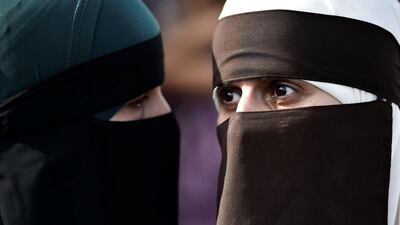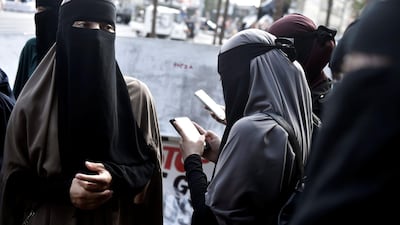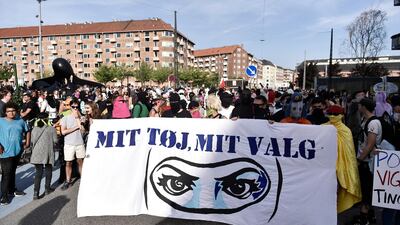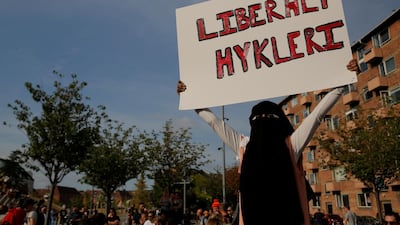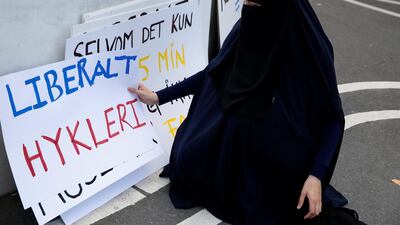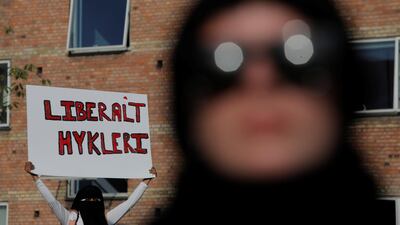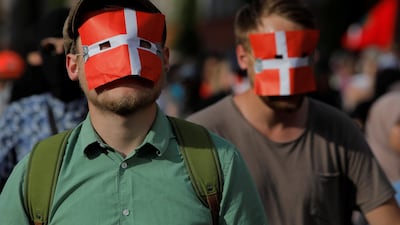Superkilen Park opened six years ago as an ode to diversity in the heart of Copenhagen. Children frolic in the Moroccan baths and skateboarders skit around the perimeter path. But, even here, some worry that Denmark’s utopian reputation is starting to unravel.
On Wednesday, Denmark became the latest country in Europe to ban the burqa, which covers a person's entire face, and the niqab, which only shows the eyes.
Passed in May, the legislation prohibits the wearing of full face veils, fining violators 1000 kroner (Dh573), although the punishments could have been far worse.
An amendment by the populist right-wing Danish People’s Party to have infringements punishable with a jail sentence did not garner enough support, but there remains a sentiment here that wants the government to go further.
Although the numbers of veil-wearing Danes is minimal – government figures published in 2010 indicate that as few as 200 women in Denmark wear either the niqab, or the burqa – the ban has touched a nerve in what remains of liberal Denmark.
It is Superkilen where they have come together to demonstrate against what they call a “hypocritical” and “illiberal” ban.
One veiled Palestinian woman poses for a selfie with a bikini-clad woman. “My clothing, My choice,” reads one banner. Others, both non-Muslims and those who already wear the hijab don veils in solidarity.
Danish police permitted the wearing of veils for the protests. But once the demonstrations ended, life had changed significantly for the contingent of women committed to covering up in public.
Aisha is a 19-year-old daughter of Turkish refugees. Born in Copenhagen, she only took up wearing the niqab two years ago, but she has no plans to shed it.
“This ban is going to affect me a lot, right now I’m finishing high school, next year I was going to go to university. I can’t do that anymore; I can’t continue my studies. I’m going to have to give up my job in a call centre too – there goes my income,” she says.
“If I walk outside the house I’m a criminal, the police will stop me," she adds. “If I am going to take off my niqab, it’s going to come from myself, I’m not going to do it because some politicians are racist.”
Proponents of the ban say it amounts to a defence of Danish values, which they argue are under threat from an increasing Muslim population. Some even suggest that Danish and Islamic values are incompatible. Others claim the ban to be a necessity in the interests of “national security”, although struggle to point to a case of the niqab being used to bypass security.
Alongside the new legislation has been a fiery discourse. Leading that rhetoric is firebrand Immigration Minister Inger Støjberg – known as “Iron Inger” for her tough positions on immigration.
Mrs Støjberg has drawn fire in recent months for suggesting that Muslims should not work during Ramadan, as well as for draconian policies, such as forcing refugees to hand over their valuables at the Danish border.
Denmark’s population has shifted in recent decades, although perhaps not as much as the populists like to claim. Since 1980, the population of ethnic Danes has stagnated, and an overall population increase of around 800,000 has been driven almost entirely by immigration.
_________________
Read more:
Editorial: Danish veil ban is thinly disguised racism
A slice of modest fashion now on offer in the heart of Italy
Quebec bans niqabs for those receiving public services
_________________
Many of these immigrant communities live in what the government has labelled "ghettos". In 2010, whilst lagging in the polls, Prime Minister Lars Løkke Rasmussen drew up a list of 29 areas based on criteria such as crime levels, income and proportion of ethnic minorities. The list saw his popularity rocket.
“It seems absurd to call areas 'ghettos' in a rich Danish welfare state,” says Aydin Soei, a sociologist who has written widely on the "ghettos" and who was himself a refugee from Iran. "I haven’t found anywhere else in Europe that does so."
Last month the government declared an intention to eliminate all such "ghettos" by 2030. The new legislation forces children who live in these low-income, predominantly Muslim neighborhoods to take mandatory citizenship lessons.
For 25 hours a week, those over the age of one will be schooled in “Danish Values” which includes learning the constitution.
One Muslim activist who asked not to be named told The National that Denmark was witnessing the normalisation of anti-minority and Islamophobic policies in its political discourse.
“It’s not just the far-right any more, even liberals and leftists – they are playing with our democratic values, selling out of the values of democracy to take these radical positions. It’s just a question of popularity, it’s not making Denmark better by bringing in this law, it’s not making the police’s job easier.”
In the case of the burqa ban, both the Liberal and Social Democrats joined their populist and conservative rivals in voting for the ban – the vote was a landslide.
“When we come close to an election, the social-democratic and leftist parties try to outdo the conservative parties, they don’t want to be seen as soft on things like immigration,” Mr Soei says.
“The result is that the Danish citizens think issues like the niqab, and the 'ghetto' lists are crisis issues, because that’s all the rhetoric focuses on, it’s not really the way.”
But the "ghetto" lists, first drawn up in 2010 have themselves been problematic. Figures and criteria have been manipulated, areas are often so small they are barely discernible on the map. The most recent list used outdated education statistics and had it used the most recent figures, the number of "ghettos" would have halved.
This manipulation is a source of frustration for Mr Soei, whose fourth book on the intricacies of the "ghettos" is titled Omar and the Others – a reference to Omar Al Hussein, a Palestinian refugee who carried out a series of shootings here in the name of ISIS three years ago.
“The main reason for the 'ghetto' lists is youth crime, but the truth is, youth crime has never been lower,” Mr Soei says.
He acknowledges there are problems in the "ghetto" areas, but warns against the dealing with them incorrectly.
“If your diagnosis is sloppy and incorrect you won’t solve the problem," he continues. "You’ll make it worse.”
